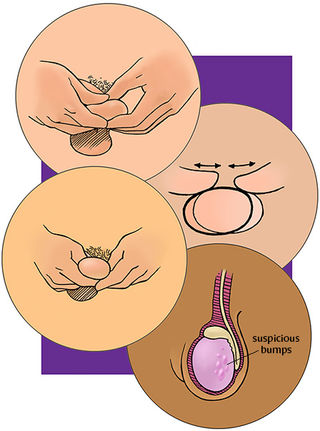Play
How to Do a Testicle Exam, and Five Reasons Men Avoid Them
How resistance gets in the way of prevention.
Posted March 23, 2013 Reviewed by Davia Sills

This isn't a medical journal, so why are instructions for doing testicular exams being posted on Psychology Today? When you consider how few men perform this simple, life-saving exam, it's time to look at the psychological issues that might get in the way.
If caught early enough, cancer of the testicles is 97 percent curable. The best way to catch it is by doing a monthly self-exam. Yet men are so phobic about doing this exam that it's often a girlfriend or spouse who discovers the suspicious change in the testicle. This is why I encourage wives and girlfriends to examine their partners every month for testicular cancer. Women don't have the resistance that men often do, and they can be sneaky about it so a partner hardly knows.
Before describing how to do the exam, I thought I'd list five psychological issues that can get in the way of men checking their testicles every month for cancer:
1. Cancer of the testicles is badly named. This cancer seldom involves both testicles. It usually only strikes one testicle. Men might be less resistant to doing monthly exams if they knew that at the very worst, they would probably only lose one testicle rather than two. Why denial works this way, I don't know. But when the stakes aren't as high as we feared, we tend to be less resistant to facing the truth.
2. Cancer of the testicles is the only common cancer that strikes men or women between the ages of 15 and 35. Unfortunately, the gene that allows us to appreciate our own mortality doesn't even begin to turn on before age 35. So the idea that one needs to check himself for a disease as serious as cancer doesn't enter a young man's consciousness.
3. Testicles are associated with manliness. Think of the go-to expression for when a male either does or doesn't have courage: "He's sure got balls," or "He needs to grow a pair." There is not another part of the male anatomy that carries the metaphorical power of the testicles. Men are highly resistant to the idea that we might lose the one part of our body that is so closely associated with manhood and courage.
4. Men often assume that women will reject them if they only have one testicle. Yet if men could read the comments women have made about scrotums on my sex survey, they would understand that not all women are as enamored with scrotums and testicles as men are. It's a rare woman who would consider only one testicle to be a deal-breaker. In fact, some men who have lost a testicle to cancer learn to play the cancer card quite effectively. Far from being put off by a scrotum with only one resident, women are sometimes curious.
5. Cancer of the testicles is seldom painful in the early stages. Some cancers of the testicles can double in size in less than 30 days with no pain. But men usually assume that if there's no pain, there's no problem. That's simply not the case with cancer of the testicles.
Hopefully, if you are a male age 15 or older, you will take resistance by the horns and start doing a monthly testicular exam. If you are the parents of a male age 15 or older, please discuss with him the importance of doing monthly testicular exams. If you are the wife or girlfriend of a male age 15 or older, I can't encourage you enough to take matters into your own hands and do a monthly exam on your man's testicles. And if you and your partner are gay or on the down low, take a few minutes every month to play doctor.

How to Do a Testicle Exam
The reason to start doing a testicular exam once a month is to learn what's normal. Only when you know what's normal will you be able to recognize changes in the early stages. (Men who don't know what's normal will sometimes freak out the first time they examine their testicles. They assume there's something wrong when there isn't.)
The best time to check your testicles is during or after a warm shower—but not when you have an erection. Erections can pull your testicles up and make them difficult to examine.
One of the things you are looking for are changes since the last time you examined your testicles. You are also checking for infections or injuries that could create a problem if not properly treated.
Use both hands. Grab a testicle. Roll the testicle between your fingers. You are looking for any bumps or lumps. They can be smaller than a pea. Check the sides really well, and the top and bottom.
Squeeze the testicle a bit. It should feel somewhat spongy. Be aware if a testicle becomes extra firm or tender or starts to lose its spongy texture. Also, note if the testicle is larger or smaller or heavier than it used to be.
There are a couple of spaghetti-like cords that attach to each testicle at the back and toward the top. They are called the epididymis. They form a structure that is shaped like a comma. It may feel a little strange, but check out your comma for any small nodes, lumps, or changes since the last time you checked. (They might feel fuller if you haven’t ejaculated in a while.)

The most common symptom to look for is a small lump or nodule on the side or sometimes the front of the testicle. It’s usually not painful when you press on it. Also see a health-care provider if the testicle starts to lose its spongy texture or feels like it’s hardening, or if it gets bigger or smaller. Less common symptoms include pain or discomfort in the testicles, extra fluid in the scrotum, back pain, swollen breasts (guy breasts), or a kind of heaviness or unusual discomfort deep in your pelvis.
Most of the things you will find in a scrotum besides testicles aren’t cancer and can often be treated with antibiotics. So if you find something worrisome, don’t assume your doctor is going to present you with bad news. One condition that can feel like cancer of the testicles is a spermatocele. This is a sperm-filled cyst in the epididymis that feels like a smaller third ball. These are pretty common and aren’t usually a problem unless they get big. Pimples on your scrotum are usually not a sign of cancer, nor is pain during urination or blood in the urine or semen.
Testicle Notes: If you ever get popped in the testicles, and the pain lasts for more than 10 minutes, have them checked by a physician. If not treated quickly, testicle trauma can cause sterility. Also, be aware that one testicle is usually bigger than the other. Nature made them that way.
The absolute mother of all testicular-cancer websites is Doug Bank’s Testicular Cancer Resource Center.
Another thorough and helpful site for men with cancer of the testicles and their families is TC-Cancer.com.
For a very unusual website on what happens when two British guys get cancer of the bullocks, visit CheckemLads.com. Mick and Phil’s personal stories are well worth the read.
Illustrations are by Daerick Gross Sr, from the “Guide To Getting It On.”




